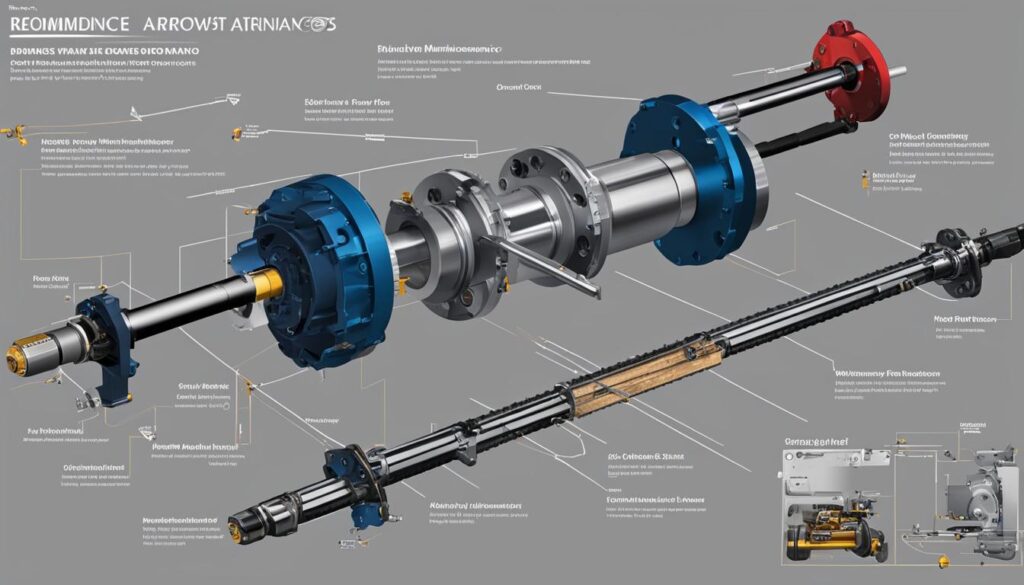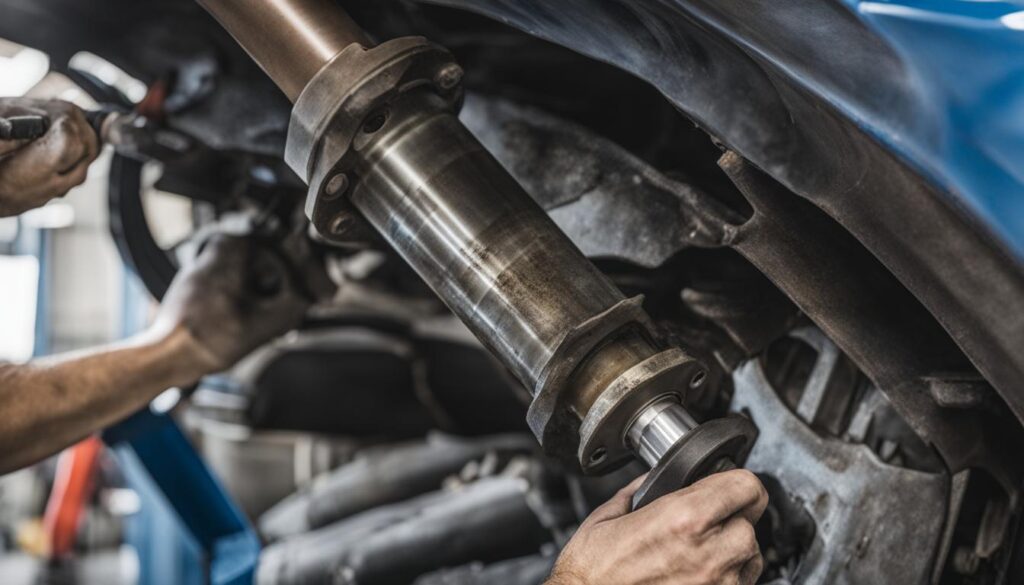When it comes to drive shaft issues, it’s important to be aware of the common problems that drivers may experience. A failing drive shaft can lead to various complications, affecting the performance and safety of your vehicle.
Signs of a bad drive shaft include vibrations, clunking noises, clicking when turning, juddering when accelerating, and squeaking. These symptoms should not be ignored, as they can indicate potential drive shaft problems that need to be addressed promptly.
Diagnosing and resolving drive shaft issues in a timely manner is crucial to ensure smooth vehicle operation and prevent further damage. In this article, I will share my expert tips on how to identify drive shaft problems and provide guidance on addressing them effectively.
Key Takeaways:
- Common drive shaft problems include vibrations, clunking noises, clicking when turning, juddering when accelerating, and squeaking.
- Ignoring drive shaft issues can lead to further damage and compromise vehicle performance and safety.
- Prompt diagnosis and resolution of drive shaft problems are essential to ensure smooth vehicle operation.
- Expert tips in this article will help you identify and address drive shaft issues effectively.
- Understanding drive shaft problems can save you time and money by preventing costly repairs in the future.
Cost of Drive Shaft Replacement and DIY Savings
When it comes to drive shaft issues, it’s important to consider the cost of replacement and the potential savings that can be achieved through DIY efforts. Knowing the drive shaft replacement cost can help you make an informed decision and determine whether tackling the replacement yourself is a viable option.
The cost of drive shaft replacement can vary depending on several factors, such as the car model and the size of the drive shaft. For smaller cars like the Fiat 500 or Ford Fiesta, the parts alone can range from £200-£300. However, for larger cars like the Ford Focus or VW Golf, the cost can be higher.
In some cases, sports cars may have even higher costs, with drive shafts exceeding £1000. Keep in mind that labor fees charged by a garage can significantly increase the overall cost. Paying an additional £400 or more for labor is not uncommon.
However, there is an opportunity to save money through DIY drive shaft replacement. If you have the necessary skills and access to a reliable guide, such as the Haynes Manual, tackling the replacement yourself can be a cost-effective option. By performing the replacement on your own, you can avoid the labor fees charged by garages, potentially saving hundreds of pounds.
Consider the Complexity and Weight of Drive Shafts
Before embarking on a DIY drive shaft replacement, it’s crucial to consider the complexity and weight of drive shafts. They are an integral part of a vehicle’s powertrain system and require proper installation to ensure safe and reliable operation.
In some cases, drive shaft replacement can be relatively straightforward for individuals with knowledge and experience in automotive repairs. However, for those without the necessary expertise, attempting a complicated drive shaft replacement can lead to mistakes or even further damage to the vehicle.
Additionally, the weight of drive shafts can make the replacement process physically demanding. It may require specialized equipment to safely remove and install the drive shaft, adding an extra layer of difficulty for DIY enthusiasts.
Consider your skill level, available resources, and the specific requirements of your vehicle when deciding whether to tackle a drive shaft replacement yourself or seek professional help.
The Potential Savings of DIY Drive Shaft Replacement
Although DIY drive shaft replacement can be challenging, it offers significant savings opportunities for car owners. By eliminating labor fees, you can save a substantial amount of money. However, it’s crucial to weigh these savings against the potential risks and difficulties associated with the DIY approach.
Cost Comparison for Drive Shaft Replacement
| Car Model | Drive Shaft Replacement Cost (Parts Only) | Approximate Total Cost (Including Labor) |
|---|---|---|
| Fiat 500 or Ford Fiesta | £200-£300 | £600-£700 |
| Ford Focus or VW Golf | £300-£500 | £700-£900 |
| Sports Cars | £500-£1000+ | £1000-£1400+ |
These table estimates provide a general idea of the cost of drive shaft replacement. Keep in mind that these costs can vary depending on other factors, such as the vehicle’s specific make, model, and additional repairs required during the process.
Ultimately, the decision to pursue a DIY drive shaft replacement should be based on your skills, resources, and comfort level with complex automotive repairs. If you are unsure or uncomfortable with the process, seeking professional assistance from a trusted mechanic or garage is always a wise choice to ensure the job is done correctly and safely.
How Drive Shafts Work and Maintenance Tips
Drive shafts play a crucial role in transferring torque from the engine and gearbox to the wheels. As one of the key components in a vehicle’s drivetrain system, drive shafts allow for smooth power delivery and enable the wheels to rotate at the same speed. Understanding how drive shafts work and implementing proper maintenance can help prevent drive shaft issues and ensure optimal performance.

How Drive Shafts Work
The drive shaft is a cylindrical metal shaft that connects the transmission or transfer case to the differential, which then transfers power to the wheels. In rear-wheel-drive vehicles, drive shafts are typically located under the car and consist of a solid metal tube with universal joints at each end. These universal joints allow the drive shaft to flex and rotate as necessary to accommodate the movement of the suspension.
In front-wheel-drive vehicles, the drive shafts connect the transaxle to the wheels and are commonly referred to as half shafts. Unlike rear-wheel-drive drive shafts, the half shafts in front-wheel-drive vehicles need to accommodate steering angles as well.
It’s important to note that drive shafts must be properly balanced to reduce vibration and minimize wear on other drivetrain components. The balance is achieved by adding counterweights along the length of the drive shaft, ensuring smooth rotation at high speeds.
Drive Shaft Maintenance Tips
Maintaining drive shafts is essential in preventing issues and maximizing their lifespan. Here are some maintenance tips to keep your drive shafts in good condition:
- Perform regular visual inspections: Check for any signs of damage, such as cracks, rust, or loose connections. Pay attention to the condition of the universal joints and look for any leaks or excessive play.
- Clean and lubricate the shafts: Remove any dirt, grime, or debris from the drive shafts using a non-abrasive cleaner. Apply a suitable lubricant to the universal joints, ensuring smooth movement and reducing friction.
- Ensure proper balance: If you experience excessive vibrations or notice uneven tire wear, it may indicate a balance issue with the drive shafts. Consult a specialized service center to perform a balance check and make any necessary adjustments.
By following these maintenance tips, you can help prevent common drive shaft issues and extend the lifespan of your drive shafts, ensuring smooth and reliable vehicle operation.
| Drive Shaft Maintenance Tips | Benefits |
|---|---|
| Perform regular visual inspections | – Early detection of damage – Prevent potential issues – Optimal performance |
| Clean and lubricate the shafts | – Smooth movement – Reduced friction – Enhanced durability |
| Ensure proper balance | – Minimized vibrations – Prevented wear on other components – Improved handling |
Regular drive shaft maintenance is a proactive approach to ensure the smooth operation of your vehicle’s drivetrain system. By taking care of your drive shafts, you can prevent potential issues, maximize their longevity, and enjoy a safe and comfortable driving experience.
Conclusion
After discussing drive shaft issues and their solutions, it’s evident that proper troubleshooting and maintenance are crucial for resolving and preventing problems. By being aware of common drive shaft issues such as torn covers, clicking noises, and vibrations, drivers can take proactive measures to address these issues promptly. Regular inspections, cleaning, lubrication, and balancing are essential to maintain optimal drive shaft performance and ensure longevity.
While DIY replacements can save money, it’s essential to consider the complexity of the task. Some individuals may have the skills and resources necessary for successful drive shaft replacement, but others may prefer to seek professional help to avoid potential complications.
By taking care of your drive shafts, you can ensure smooth vehicle operation and prevent costly repairs in the future. Don’t ignore the warning signs. Troubleshoot drive shaft issues promptly and perform routine maintenance to maximize drive shaft longevity and protect your investment.
FAQ
What are the signs of a failing drive shaft?
Signs of a failing drive shaft include vibrations, clunking noises, clicking when turning, juddering when accelerating, and squeaking.
How much does it cost to replace a drive shaft?
The cost of drive shaft replacement can vary depending on the car model. For smaller cars like the Fiat 500 or Ford Fiesta, the parts alone can range from £200-£300, while drive shafts for larger cars like the Ford Focus or VW Golf can cost more. Sports cars may have even higher costs, with drive shafts exceeding £1000. Paying for labor fees at a garage can add an additional £400 or more to the total cost.
Can I replace the drive shaft myself?
DIY replacement can save you money if you have the skills and a reliable guide, like the Haynes Manual. However, it’s important to consider the complexity and weight of drive shafts when deciding whether to tackle the replacement yourself or seek professional help.
How does a drive shaft work and what maintenance is required?
Drive shafts play a crucial role in transferring torque from the engine and gearbox to the wheels. Routine maintenance is essential to keep drive shafts in good condition. This includes performing regular visual inspections, cleaning and lubricating the shafts, and ensuring proper balance through a specialized service center.
How can I troubleshoot drive shaft issues?
By being aware of common drive shaft problems like torn covers, clicking noises, and vibrations, drivers can take the necessary steps to address these issues promptly. Regular inspections, cleaning, lubrication, and balancing can help maintain drive shaft performance and prolong their lifespan.




